How Artificial Intelligence is Transforming Human Resources and the Workforce

Other more routine uses include using chatbots to perform repetitive tasks, such as retrieving plan information to communicate to members and answering basic employee questions about plans.
However, HR professionals should keep in mind some potential pitfalls. For example, employers will need to verify identities carefully. Bad actors will likely deploy AI to gain personalized data that can later be used for fraud. These schemes already exist, but may be more widespread as AI permeates this space.
Another risk is data security. Employers will want to think carefully about which data should and should not be accessible by AI. Sending an employee’s personal identifiable information over the internet may expose the organization to a data breach.
Another tool being used in retirement is predictive analytics to prepare custom estimates of pensioner life expectancy for base mortality tables.
Outlook and Strategies for AI in Talent Management
It is likely that no area of HR will be affected as profoundly by AI as talent management professionals. As AI is integrated into business strategy, preparing the workforce to use the new technology is critical. AI could require new skills, new jobs and new ways of working. An internal AI model can help predict employee retention or flight risks. Once identified, interventions can be recommended or even implemented by the AI model on behalf of a manager. For example, an employee may receive a reminder about an Employee Assistance Program if they signal to the AI model that they need help managing stress. Managing those requirements will fall to talent management professionals.
“The clients that I talk to know they have so much they need to comprehend that they’re having trouble figuring out where to focus first,” says Marc Pajarillo, a partner in Aon’s Talent practice. “By and large, organizations need to start thinking about how all jobs will be substantively changed today versus tomorrow — and we’re helping them with this by analyzing jobs and seeing what can be automated compared to augmented and how they need to redesign jobs.”
Economists have been making predictions that new technologies would replace laborers since the Industrial Revolution.1 These predictions tend to overstate the degree to which workers would be replaced entirely, and undervalue the notion that workers would adapt, reskill and use the increased productivity afforded by automation to increase overall output. Thus, talent professionals should be looking toward preparing for the use of AI through the lens of reskilling and upskilling, as well as planning for the creation of new jobs to help manage AI successfully.
Using Aon’s extensive global workforce database, we analyzed the potential impact of AI on jobs across several industries. In the technology industry, we found 32 percent of job roles and 69 percent of headcount are at risk of significant disruption from AI. The level of disruption can vary greatly by industry. By contrast, our analysis of life sciences firms found 23 percent of job roles and 34 percent of headcount are at risk of significant disruption from AI.
While different industries will experience different levels of disruption, there is a constant across industries: HR professionals will need to lead the charge to both use the technology responsibly and prepare the workforce for its adoption. When we analyzed the HR function across industries, we found that 24 percent of roles and 58 percent of headcount will be disrupted.
A comprehensive strategy starts with workforce planning, including determining which jobs the organization needs and the effect on overall job architecture. While it’s interesting to know the projected overall disruption that AI will create in a given industry, it is more useful for HR and business leaders to understand the types of jobs that will be disrupted.
For instance, in the life sciences example above, some of the sector-specific roles that are most likely to be impacted include:
- Medical & Technical Writers
- Clinical (SAS) Programmer
- Managed Care Contracts Manager
- Medical Billing Specialist
- Regulatory Affairs Associate
- Pricing & Policy Strategist
- Clinical Trials Administrator
- Digital Health Platform Developer



